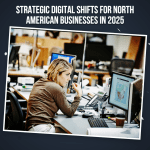The modern workplace is undergoing profound transformation. Employers in North America, particularly small and medium-sized enterprises, are navigating an increasingly competitive labor market shaped by rapid technological change, shifting workforce expectations, and the ongoing need to balance productivity with employee satisfaction. In this environment, understanding what employers truly value when hiring and retaining talent has become essential for building sustainable organizations.
This article examines the core priorities employers emphasize today, from the growing focus on skills-based hiring to the importance of workplace culture and government-supported workforce development initiatives.
Skills as the Primary Hiring Currency
In the contemporary job market, employers are moving away from a reliance on traditional academic degrees and instead prioritizing skills. This shift reflects both necessity and opportunity. According to recent research, only about one in four workers globally express confidence that their skills will ensure career advancement over the next three years.
For employers, the implication is clear: skills now serve as the true hiring currency. Companies that recruit based on proven competencies, adaptability, and the capacity for continuous learning stand a better chance of meeting their evolving needs. By emphasizing skill acquisition over credentials, small businesses in particular can expand their talent pools and remain agile in a dynamic market.
The Strategic Imperative of Upskilling and Reskilling
By 2027, it is estimated that nearly half of all job skills will change due to automation, digital transformation, and emerging technologies. Employers are therefore making significant investments in both upskilling, which enhances existing employee capabilities, and reskilling, which equips workers with new competencies for emerging roles.
Partnerships with community colleges, vocational programs, and online learning platforms have become critical to this process. These investments not only ensure that employees remain relevant but also strengthen organizational resilience. Businesses that support workforce development internally position themselves to adapt more effectively to industry shifts and technological disruptions.
Technology Competence as a Non-Negotiable
Digital transformation has established technical expertise as a critical factor in workforce readiness. Employers consistently seek individuals with knowledge of artificial intelligence, cybersecurity, big data, and cloud computing. The increasing popularity of short-term certifications and micro-credentials highlights the demand for rapid, practical learning solutions.
Importantly, technology competence is not confined to information technology departments. Functions such as marketing, operations, finance, and customer service increasingly rely on employees who can leverage digital tools. Organizations that cultivate technical proficiency across departments establish a competitive advantage and ensure that innovation is embedded throughout their operations.
The Growing Importance of Human Skills
While technical competence is vital, employers recognize that it cannot exist in isolation. Human skills, often referred to as soft skills, are highly valued in the current workplace. These include adaptability, communication, teamwork, critical thinking, and resilience.
The rise of hybrid and remote work arrangements underscores the importance of these qualities. Teams distributed across multiple locations rely on collaboration, empathy, and problem-solving to maintain effectiveness. Employers who prioritize human skills in their hiring and training strategies foster workplace cultures that are adaptable, collaborative, and capable of navigating uncertainty.
Training as a Retention Mechanism
Training is no longer viewed solely as professional development. It has become a central mechanism for employee retention. Workers today actively seek employers who provide opportunities for growth and advancement. Conversely, inadequate training programs are frequently cited as reasons employees disengage or leave.
Forward-looking companies are investing in blended learning models that combine classroom training with digital-first approaches such as virtual workshops, e-learning platforms, and mentorship programs. By creating flexible, accessible learning opportunities, employers not only improve workforce capabilities but also demonstrate a tangible commitment to employee success.
This commitment fosters loyalty and reduces turnover, ensuring organizations retain skilled talent in competitive markets.
Workplace Culture as a Decisive Factor
Culture has emerged as a defining element in both recruitment and retention. Beyond compensation and benefits, employees evaluate organizations on the basis of their values, leadership styles, and overall work environment.
Employers that articulate a strong employee value proposition, built around meaningful work, professional development, and clearly defined organizational values, enjoy a distinct advantage. For small and medium-sized enterprises, culture often becomes their most effective recruitment tool. A supportive, inclusive, and engaging culture not only attracts top candidates but also sustains long-term commitment among existing employees.
The Role of Public Investment in Workforce Development
Public policy plays an increasingly important role in shaping the labor market. Across Canada and the United States, government initiatives are expanding support for workforce training, reskilling, and apprenticeships in high-growth sectors such as healthcare, skilled trades, and technology.
For employers, participation in these programs presents both strategic and financial advantages. Leveraging publicly funded training resources reduces the burden on businesses while enhancing employee capabilities. More importantly, it signals a long-term commitment to workforce development, which resonates with both current and prospective employees.
Conclusion: Defining Priorities in a Competitive Workplace
The priorities employers value most in today’s workplace reflect a convergence of adaptability, technical competence, and human-centered leadership. Hiring strategies increasingly emphasize skills over credentials, while ongoing investments in training, upskilling, and reskilling are critical to organizational resilience. Human skills such as adaptability, critical thinking, and collaboration are indispensable complements to technical knowledge.
Equally important is the role of workplace culture and employee value propositions in attracting and retaining talent. Employers who foster supportive environments, invest in flexible training, and align with public workforce initiatives position themselves for long-term success.
In an era of continuous change, the most competitive organizations will be those that view workforce development not as a secondary priority but as a strategic foundation. By aligning hiring and retention strategies with the realities of a rapidly evolving labor market, employers can ensure they are not only meeting present needs but also preparing for the demands of the future.









